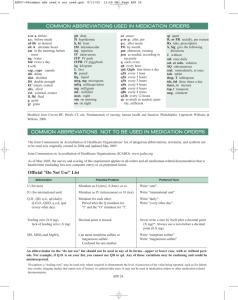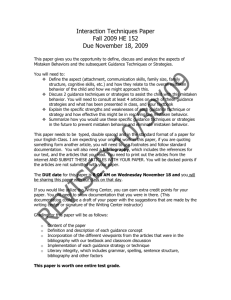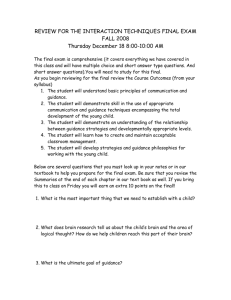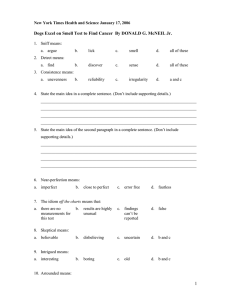Country Health SA Local Health Network :: SA Health
advertisement
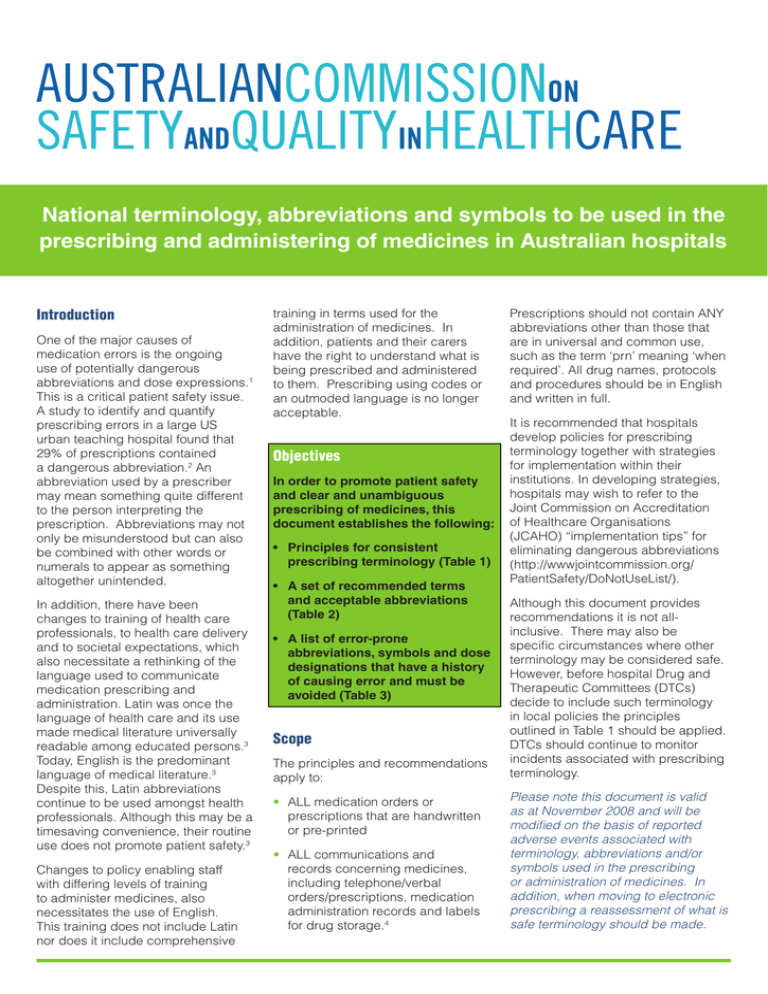
National terminology, abbreviations and symbols to be used in the prescribing and administering of edicines in Australian Introduction One of the major causes of medication errors is the ongoing use of potentially dangerous abbreviations and dose expressions.1 This is a critical patient safety issue. A study to identify and quantify prescribing errors in a large US urban teaching hospital found that 29% of prescriptions contained a dangerous abbreviation.2 An abbreviation used by a prescriber may mean something quite different to the person interpreting the prescription. Abbreviations may not only be misunderstood but can also be combined with other words or numerals to appear as something altogether unintended. In addition, there have been changes to training of health care professionals, to health care delivery and to societal expectations, which also necessitate a rethinking of the language used to communicate medication prescribing and administration. Latin was once the language of health care and its use made medical literature universally readable among educated persons.3 Today, English is the predominant language of medical literature.3 Despite this, Latin abbreviations continue to be used amongst health professionals. Although this may be a timesaving convenience, their routine use does not promote patient safety.3 Changes to policy enabling staff with differing levels of training to administer medicines, also necessitates the use of English. This training does not include Latin nor does it include comprehensive training in terms used for the administration of medicines. In addition, patients and their carers have the right to understand what is being prescribed and administered to them. Prescribing using codes or an outmoded language is no longer acceptable. Objectives In order to promote patient safety and clear and unambiguous prescribing of medicines, this document establishes the following: • Principles for consistent prescribing terminology (Table 1) • A set of recommended terms and acceptable abbreviations (Table 2) • A list of error-prone abbreviations, symbols and dose designations that have a history of causing error and must be avoided (Table 3) Scope The principles and recommendations apply to: • ALL medication orders or prescriptions that are handwritten or pre-printed • ALL communications and records concerning medicines, including telephone/verbal orders/prescriptions, medication administration records and labels for drug storage.4 Prescriptions should not contain ANY abbreviations other than those that are in universal and common use, such as the term ‘prn’ meaning ‘when required’. All drug names, protocols and procedures should be in English and written in full. It is recommended that hospitals develop policies for prescribing terminology together with strategies for implementation within their institutions. In developing strategies, hospitals may wish to refer to the Joint Commission on Accreditation of Healthcare Organisations (JCAHO) “implementation tips” for eliminating dangerous abbreviations (http://wwwjointcommission.org/ PatientSafety/DoNotUseList/). Although this document provides recommendations it is not allinclusive. There may also be specific circumstances where other terminology may be considered safe. However, before hospital Drug and Therapeutic Committees (DTCs) decide to include such terminology in local policies the principles outlined in Table 1 should be applied. DTCs should continue to monitor incidents associated with prescribing terminology. Please note this document is valid as at November 2008 and will be modified on the basis of reported adverse events associated with terminology, abbreviations and/or symbols used in the prescribing or administration of medicines. In addition, when moving to electronic prescribing a reassessment of what is safe terminology should be made. Table 1: Principles for consistent prescribing terminology 1. Use plain English - avoid jargon 2. Write in full - avoid using abbreviations wherever possible, including Latin abbreviations 3. Print all text - especially drug names 4. Use generic drug names Exception may be made for combination products, but only if the trade name adequately identifies the medication being prescribed. For example, if trade names are used, combination products containing a penicillin (eg Augmentin®, Timentin®) may not be identified as penicillins. Exception may also be made where significant bioavailability issues exist, for example cyclosporin, amphotericin 5. Write drug names in full. NEVER abbreviate any drug name Some examples of unacceptable drug name abbreviations are: G-CSF (use filgrastim or lenograstim or pegfilgrastim), AZT (use zidovudine), 5-FU (use fluorouracil), DTIC (use dacarbazine), EPO (use epoetin), TAC (use triamcinolone) Exception may be made for modified release products For slow release, controlled release, continuous release or other modified release products, the description used in the trade name to denote the release characteristics should be included with the generic drug name, for example tramadol SR, carbamazepine CR For multi-drug protocols, prescribe each drug in full and do not use acronyms, for example do not prescribe chemotherapy as ‘CHOP’. Prescribe each drug separately 6. Do not use chemical names/symbols, for example HCl (hydrochloric acid or hydrochloride) may be mistaken for KCl (potassium chloride) Do not include the salt of the chemical unless it is clinically significant, for example mycophenolate mofetil or mycophenolate sodium. Where a salt is part of the name it should follow the drug name and not precede it 7. Dose • Use words or Hindu-Arabic numbers, ie 1, 2, 3 etc Do not use Roman numerals, ie do not use ii for two, iii for three, v for five etc • Use metric units, such as gram or mL Do not use apothecary units, such as minims or drams • Use a leading zero in front of a decimal point for a dose less than 1, for example use 0.5 not .5 Do not use trailing zeros, for example use 5 not 5.0 • For oral liquid preparations, express dose in weight as well as volume, for example in the case of morphine oral solution (5mg/mL) prescribe the dose in mg and confirm the volume in brackets: eg 10mg (2mL) • Express dosage frequency unambiguously, for example use ‘three times a week’ not ‘three times weekly’ as the latter could be confused as ‘every three weeks’ 8.Avoid fractions, for example - 1/7 could be interpreted as ‘for one day’, ‘once daily’, ‘for one week’ or ‘once weekly’ - 1/2 could be interpreted as ‘half’ or as ‘one to two’ 9. Do not use symbols 10.Avoid acronyms or abbreviations for medical terms and procedure names on orders or prescriptions, for example avoid EBM meaning ‘expressed breast milk’ 2 TABLE 2: Acceptable terms and abbreviations The following table lists the terms and abbreviations that are commonly used and understood and therefore considered acceptable for use. Where there is more than one acceptable term the preferred term is shown first in the right hand column. Intended meaning Acceptable Terms or Abbreviations Dose Frequency or Timing (in the) morning morning, mane (at) midday midday (at) night night, nocte twice a day bd three times a day tds four times a day qid every 4 hours every 4 hrs, 4 hourly, 4 hrly every 6 hours every 6 hrs, 6 hourly, 6 hrly every 8 hours every 8 hrs, 8 hourly, 8 hrly once a week once a week and specify the day in full, eg, once a week on Tuesdays three times a week three times a week and specify the exact days in full, eg three times a week on Mondays, Wednesdays and Saturdays when required prn immediately stat before food before food after food after food with food with food Route of administration epidural epidural inhale, inhalation inhale, inhalation intraarticular intraarticular intramuscular IM intrathecal intrathecal intranasal intranasal intravenous IV irrigation irrigation left left nebulised NEB naso-gastric NG oral PO percutaneous enteral gastrostomy PEG per vagina PV per rectum PR peripherally inserted central catheter PICC right right subcutaneous subcut sublingual subling topical topical 3 TABLE 2: Acceptable terms and abbreviations (continued) The following table lists the terms and abbreviations that are commonly used and understood and therefore considered acceptable for use. Where there is more than one acceptable term the preferred term is shown first in the right hand column. Intended meaning Acceptable Terms or Abbreviations Units of Measure and Concentration gram(s) g International unit(s) International unit(s) unit(s) unit(s) litre(s) L milligram(s) mg millilitre(s) mL microgram(s) microgram, microg percentage % millimole mmol Dose Forms 4 capsule cap cream cream ear drops ear drops ear ointment ear ointment eye drops eye drops eye ointment eye ointment injection inj metered dose inhaler metered dose inhaler, inhaler, MDI mixture mixture ointment ointment, oint pessary pess powder powder suppository supp tablet tablet, tab patient controlled analgesia PCA TABLE 3: Error-prone abbreviations, symbols and dose designations to be avoided (Adapted from the Institute of Safe Medication Practices [ISMP] list of the same name4, with permission from ISMP) Error-prone Abbreviation Intended Meaning Why? 4 What should be used 8 4 µg, mcg or ug microgram Mistaken as ‘mg’ microgram BID or bid twice daily Mistaken as ‘tid’ (three times daily) bd BT or bt bedtime Mistaken as ‘BID’ (twice daily) bedtime cc cubic centimetres Mistaken as ‘u’ (units) mL D/C discharge or discontinue Premature discontinuation of medications if discharge ‘discharge’ or intended ‘discontinue’ whichever is intended e or E ear or eye Mistaken for ‘ear’ when ‘eye’ intended or for ‘eye’ when ‘eye’ or ‘ear’ and specify ‘ear’ intended whether ‘left’, ‘right’ or ‘both’ gtt or gutte drops Latin abbreviation meaning ‘drops’, not universally ‘drops’ or ‘eye drops’ understood. whichever is intended HS half-strength Mistaken as bedtime ‘half-strength’ or hs at bedtime, hours of sleep Mistaken as half-strength ‘bedtime’ whichever is intended IJ injection Mistaken as ‘IV’ or ‘intrajugular’ injection IN intranasal Mistaken as ‘IM’or ‘IV’ intranasal IT intrathecal Mistaken as Intravenous intrathecal IU International units Mistaken as ‘IV’ (Intravenous) or ‘10’ (ten) International units M morning Mistaken for ‘n’ (night) morning N night Mistaken for ‘m’ (morning) night Oc or Occ eye ointment Mistaken for eye drops eye ointment mist mixture Latin abbreviation, not universally understood mixture o.d. or OD once daily Mistaken as ‘right eye’ (OD-oculus dexter), leading to ‘daily’, preferably oral liquid medications administered in the eye. Can specifying the time of the also be mistaken for BD (twice daily) day, eg ‘morning’, ‘midday’, ‘at night’ OJ orange juice Mistaken as ‘OD’ or ‘OS’ (right or left eye); drugs meant orange juice to be diluted in orange juice may be given in the eye OW once a week Not universally understood once a week p/f per fortnight Not universally understood every two weeks, per fortnight qd or QD every day Mistaken as ‘Qid’, especially if the period after the ‘q’ or daily the tail of the ‘q’ is misunderstood as an ‘i’ pulv powder Latin abbreviation, not universally understood powder Qhs nightly at bedtime Mistaken as ‘qhr’ or every hour ‘night’, ‘daily at bedtime’ Qh every hour Not universally understood ‘hourly’, qod or QOD every other day Mistaken as ‘qd’ (daily) or ‘qid’ (four times daily) ‘every second day’, ‘every hour’ ‘on alternate days’ Q6PM etc every evening at 6 pm Mistaken as every six hours ‘6pm daily’, ‘every night at 6pm’, ‘every day at 6 pm’ 5 TABLE 3: Error-prone abbreviations, symbols and dose designations to be avoided (continued) (Adapted from the Institute of Safe Medication Practices [ISMP] list of the same name4, with permission from ISMP) Error-prone Abbreviation Intended Meaning Why? What should be used 8 4 SC subcutaneous Mistaken as ‘SL’ (Sublingual) ‘subcut’, ‘subcutaneous’ SL or S/L sublingual Mistaken as ‘SC’ (Subcutaneous) ‘subling’, ‘under the tongue’ Ss sliding scale (insulin) or Mistaken as ‘55’ ‘sliding scale’ or ‘half’ half (apothecary) SSRI or SSI whichever is intended sliding scale regular insulin Mistaken as selective serotonin reuptake inhibitor; sliding scale insulin or sliding scale insulin Mistaken as Strong Solution of Iodine (Lugols) TID three times a day Mistaken as ‘bd’ tds TIW three times a week Mistaken as ‘three times daily’ ‘three times a week’ and specify exact days in full, for example ‘on Mondays, Wednesdays and Saturdays’ i/D one daily Mistaken as ‘tid’ one daily U or u unit Mistaken as the numbers ‘0’ or ‘4’, causing a 10-fold unit overdose or greater (eg 4U seen as ‘40’ or 4u seen as ‘44’). Mistaken as ‘cc’ so dose given as a volume instead of units (eg 4u seen as 4 cc) ung ointment Error-prone frequency and dosage abbreviations Latin abbreviation, not universally understood Intended Meaning Why? ointment What should be used 8 6/24 4 every six hours Mistaken as ‘six times a day’ ‘every 6 hrs’, ‘6 hourly’, ‘6 hrly’ 1/7 for one day Mistaken as ‘for one week’ for one day only 1/2 half Mistaken as ‘one or two’ half i, ii,iii,iv (Roman 1,2,3,4 etc numerals) 6 Hindu-Arabic numbers, 1,2,3,4 etc or words TABLE 3: Error-prone abbreviations, symbols and dose designations to be avoided (continued) (Adapted from the Institute of Safe Medication Practices [ISMP] list of the same name4, with permission from ISMP) Error-prone dose designations and other information Intended meaning Why? What should be used 8 Trailing zero after 4 1mg Mistaken as 10mg if the decimal point is not seen decimal point for doses expressed in (eg 1.0mg) No leading zero Do not use trailing zeros whole numbers 0.5mg Mistaken as 5mg if the decimal point is not seen Use zero before a before a decimal decimal point when point (eg .5mg) the dose is less than a whole unit Large doses 100,000 units 100000 has been mistaken as 10,000, or 1,000,000; For figures above 100 without properly 1,000,000 1000000 has been mistaken as 100,000 use words to express placed commas intent eg, one thousand, (eg 100000units, one million, six million 1000000 units) etc. Otherwise use commas for dosing units at or above 1,000 10 etc one million 6 Not universally understood Use one million or 1,000,000 Error-prone symbols Intended Meaning Why? What should be used 8 4 X3d for three days Mistaken as ‘3 doses’ for three days > or < greater than or less than Mistaken or used as the opposite of intended; ‘<10’ ‘greater than’ or mistaken as ‘40’ ‘less than’ separates two doses or Mistaken as the number 1 eg ‘25 units/10units’ misread as ‘per’ rather than a slash indicates ‘per’ ‘25 units and 110 units’ mark to separate doses @ at Mistaken as ‘2’ at & and Mistaken as ‘2’ and + plus or and Mistaken as ‘4’ and ˚ hour Mistaken as a zero (eg q2˚ seen as q20) hour / (slash mark) 7 This document was prepared by a Working Group of the NSW TAG Safer Medicines Group in consultation with health practitioners and with reference to the following documents: • St Vincent’s Hospital, Sydney, Standard Abbreviations for Prescribing (adapted with permission from Central Coast Health) • Sydney Children’s Hospital, Recommendations on ‘Safe Prescribing’ October 03 • National Prescribing Service – National Prescribing Curriculum. • Australian Medicines Handbook 2006 • Prince of Wales Hospital and Sydney Children’s Hospital approved list of abbreviations • National Inpatient Medication Chart – NSW Health Guidelines for use Working Group Members Ms Jill Arcus, Pharmaceutical Services Branch, NSW Health Department Assoc/Prof Robyn Gallagher, Faculty of Nursing, Midwifery and Health, University of Technology, Sydney Ms Linda Graudins, Quality Use of Medicines Pharmacist, Sydney Children’s Hospital Ms Maria Kelly, Executive Officer, NSW Therapeutic Advisory Group • Australian Pharmaceutical Formulary and Handbook (APF), 19th Edition Ms Josephine Montgomery, Quality and Safety Branch, NSW Health Department • Joint Commission on Accreditation of Healthcare Organisations (JCAHO), Medication errors related to potentially dangerous abbreviations 2001 Dr Gary Nicholls, Clinical Pharmacologist, St Vincent’s Hospital, Sydney • Institute for Safe Medication Practices (ISMP), List of Error-Prone Abbreviations, Symbols, and Dose Designations, 2005 • NSW Health Policy Directive PD2005_206, ‘Policy on the Handling of Medication in New South Wales Public Hospitals’ • Queensland Health Department’s state-wide abbreviation guidelines used in prescribing and administering medications. NSW TAG gratefully acknowledges all those who provided comment during the consultation phase. The working group also acknowledges the assistance of Karen Kaye, Executive Officer, NSW TAG References: NSW Therapeutic Advisory Group Level 5, 376 Victoria Street PO Box 766 Darlinghurst NSW 2010 Phone: 61 2 8382 2852 Fax: 61 2 8382 3529 Email: nswtag@stvincents.com.au www.nswtag.org.au 1.JCAHO. Sentinel Event Alert - Medication errors related to potentially dangerous abbreviations: Joint Commission on Accreditation of Healthcare Organisations, 2001. 2.Garbutt J, Milligan P, McNaughton C, Waterman B, Clairborne Dunagan W, Fraser V. A Practical Approach to Measure the Quality of Handwritten Medication Orders. J Patient Saf 2005; 1:195-200. 3.Dunn E, Wolfe J. Let Go of Latin! Vet Human Toxicol 2001; 43:235-236. 4.ISMP. List of Error-Prone Abbreviations, Symbols, and Dose Designations: Institute for Safe Medication Practices, 2005. October 2006 8 Australian Commission on Safety and Quality in Health Care Level 7, 1 Oxford Street Darlinghurst NSW 2010 Phone: 61 2 9263 3616 Fax: 61 2 9263 3613 Email: mail@safetyandquality.gov.au www.safetyandquality.gov.au
